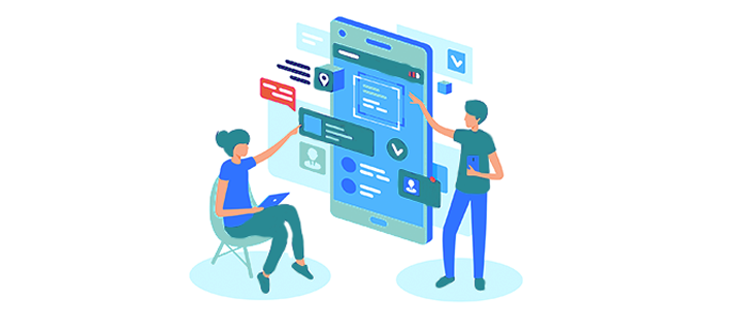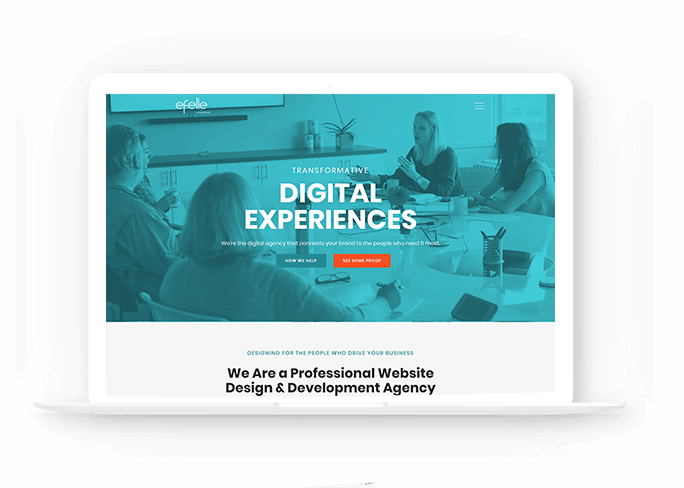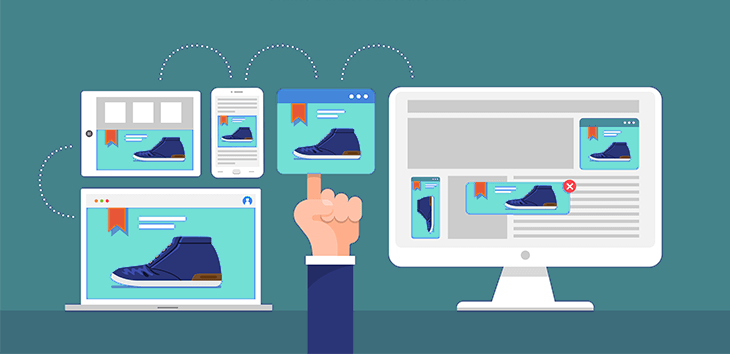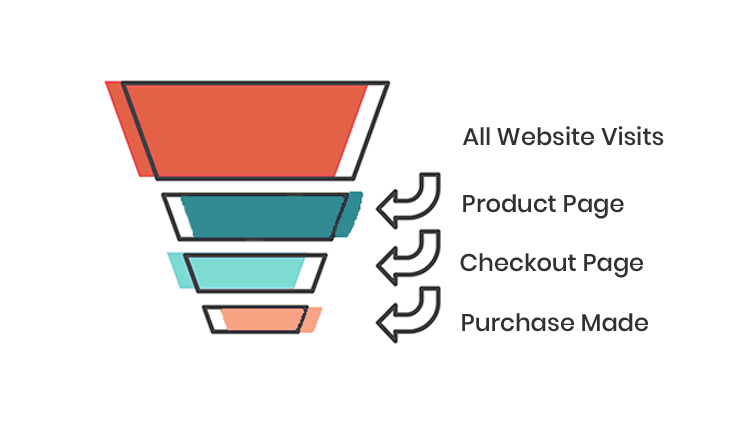Average Order Value, Bounce Rates, & Conversion Rate Optimization - The ABC's of eCommerce

The eCommerce Website Terms You Need to Know
In the world of web, there's a lot of terms to keep up with, and especially when it comes to operating an eCommerce store. Here's our list of your need-to-know vocabulary.
To download this resource fill out this form so you can reference it in the future:
A/B Testing
Also known as split testing, A/B testing is the comparison of two different options for something to see how they perform. This is a great idea to get a better understanding of how your audience will react to something.
For example, if you’re trying out a landing page for a promotion, A/B test the color of the calls to action and see if one performs better. This will allow you to understand how to best optimize your website in terms of data rather than guessing what will perform better.
Average Order Value - AOV
This is the average amount that your customers spend on your website per order. This can be found by dividing your revenue by number of orders. This is a good benchmark for understanding how your customers shop and if there's an opportunity to increase revenue through increasing your “AOV.”
Bounce Rate
First, you should understand a bounce, which is a single page session on your site, meaning someone visiting one page one time. The bounce rate is the single page sessions divided by all the sessions (or times people were on your site) that have occurred. Basically, a bounce occurs when someone visits your site and doesn’t interact with it.
Call to Action - CTA
A term dedicated to the device or piece of a design to prompt or encourage people to convert. These are designed strategically to get the user to reach your final goal. This can be anything from making a purchase, downloading a Whitepaper, reaching out to contact you, and etc.
Cart Abandonment Rate
This is the rate in which users put a product in their cart and then leave without making a purchase. The typical rate averages between 60% and 80%. This leaves a lot of missed revenue and is a good space for digital marketing strategy to be implemented to “recover” the carts.
Content Management System - CMS
A CMS is what handles the digital content - photos, images, words, etc. on your website. Rather than making changes with code, your website is made with a CMS to make changes easier and more intuitive without needing to know code. These can include dashboards to monitor website performance, a strong structure for SEO, different users and permissions, templates based on design and much more.
Conversion Rate
The number of people who “convert” on your site, divided by the number of visitors you receive. Converting can be making a purchase, filling out a form, or accomplishing whatever “goal” you have for your website.
Conversion Rate Optimization - CRO
CRO are tactics to increase your conversion rate - converting users into customers. These can be chatbots on your homepage, a blog with targeted content, or landing pages for promotions. The best tactics are dependent upon your website.
Cross-Selling
The practice of selling additional products to already existing customers. This can be adding complementary products to a purchase the user is already intending to make. This could be a case or charger for a piece of technology or recommending a shirt that will go with a pair of pants the user is buying. This can be done during the checkout process or post-sale for additional products. This is a way to increase your average order value.
Customer Experience - CX
The CX is taking a step back to look at the whole experience the customer is having. This can be from your website to your social media to your actual product. Taking a look at the holistic experience your customer is having can help you understand where there can be gaps in your process and places to improve. Having a positive CX can increase loyalty, customer satisfaction and recommendations for your business.
Customer Lifetime Value - CLV
The customer lifetime value is a number produced to predict the net profit that a customer can potentially produce. This is valuable to understanding how you treat your customers, and since maintaining your current customers is less expensive than finding new ones, making sure you have a high CLV is important and cost-effective.
Hero Image (or Masthead)
This is the large image at the top of your homepage. This is prominently placed and often crucial to first impressions on your website. This can be changed out based on seasons, possible sales, and other business promotions. For eCommerce sites, this is crucial to capturing your audience and often features a Call to Action.

Key Performance Indicator - KPI
A KPI is a way of measuring how effective a tactic is in achieving a goal. Key Performance Indicators can differ between companies, but specifically for eCommerce and marketing, they can be things like conversion rates, average order value, ROI for Ad Spend, or abandoned cart rate. These should be set specifically to match the goals of your business with the understanding that they can change over time as your priorities change.
Landing Page
A landing page is a standalone page of your website specifically made for a promotion or to be directed to from an advertisement. They often have a specific purpose and are simpler in design. These often have one specific call to action, with one specific goal in mind.
For example, if you have a sale on a specific item and are running advertisements, you can send the ads to that page, which is designed to sell that specific item, touting features, benefits, and directing you to purchase right on the page.
Omnichannel
Having an omnichannel experience for your users means that on whatever medium your users are finding you on - whether it’s on the desktop version of your website, your Instagram, your emails, or an advertisement - it should be consistent. Now more than ever it’s important for users to be able to click from seeing your Instagram over to your mobile site and not be surprised by your branding or user experience.
Pay-Per-Click Ads
Pay-Per-Click or PPC advertisements are a type of digital marketing done on search engines (like Google and Bing) where the business is only charged per click. These are shown at the top of the search engine, based off the term that was searched. For example, if you sell tie-dye t-shirts, you could produce an ad for the search term “tie-dye t-shirts,” so when someone searches for it, your business would pop up. That being said, the more popular the term, the more expensive the cost per click can be. You also are bidding against other businesses attempting to do the same, meaning the moment that a searcher types in “tie-dye t-shirts,” Google is performing a complex algorithm to decide upon the winning bids and in what order the ads show.

Retargeting Ads
Retargeting Advertisements are created with a warm opening in that the receiver has to have visited your site at one point in time, so you are advertising to someone who has already shown interest. These ads are created to bring potential buyers who didn’t purchase anything back to your site. They’re tracked using “cookies,” and show ads on places like Facebook, news outlets, blogs, and any other sites that allow for ads.
Return on Investment - ROI
You return on investment is exactly as it states - if you’re investing money in something, are you receiving that money or more back to pay for it? Calculating your ROI is a great way to see if you should be spending more or less money on your digital marketing. In terms of spending more, it may seem intimidating to spend a few thousand dollars on Pay-Per-Click ads, but if you get double that back in sales, it is obviously a positive ROI. If you are investing in something and not seeing a return, then try going without for a few months to see how your business fares without it.
Sales Funnel
Similar to a service business, eCommerce websites have a funnel in which their users go down as they get closer to buying. The top of the funnel is users on your website, from there it goes down to user sessions with a product view (often around 40-50%), then the number of sessions in which a user adds something to cart, then finally, the smallest portion of the funnel is the number of sessions in which a user makes a purchase.
By understanding this funnel, you can look at your total number of user sessions on your site and watch as the number decreases at each new level of the funnel. Here you can understand possible spots for optimization - are a lot of users stopping at product pages? Maybe there is something confusing about your products. Maybe you have a lot of users adding to cart but not making a purchase - is your shipping too high? Or maybe there’s a lot of people on your homepage but they never go further than that - does your site architecture make sense? Are your calls to action strong enough?

Search Engine Optimization - SEO
SEO is a hot topic these days and has been since the start of the internet. SEO involves a lot of things, but overall, it’s the process of increasing the quality and size of the traffic coming to your website from a search engine. SEO allows you to increase visibility based on optimization of “keywords,” related to your business. This can be through backlinking, keywords in your headers, URL structure, and much more. The tactics are dependent upon your business and industry, but we highly recommend making it a part of your strategy.
Upselling
This is the process of offering the next level product to a consumer intending to make a purchase. This can be done by showing a comparison chart of the higher end product comparative to the current one. This is done by showing the increased value of choosing the newer, more advanced, or premium item.
For example, this is like showing the newest version of the iPhone when a customer is looking to purchase one of lesser value or last years version. If they're already looking to commit a certain sum of money, you're more likely to capture their attention and get them to increase their order value by attempting to upsell them on a higher-value product.
User Flow
The user flow is the path that your website viewer or user takes on your website. This follows them from the entry point onto your website (from an advertisement, search engine, or straight from the URL) all the way to their purchase.
Here’s an example User Flow:
- A user has visited before, so they type in your URL and land on your homepage.
- The user might click on the category of the product they’re looking to buy.
- They click on the product they’re looking for, scroll down to read reviews, then add the item to their cart.
- Next, the user goes to the shopping cart page and enters their info.
- Finally, they complete the purchase.
Knowing the path that your user might take is important so that you can optimize the experience throughout the flow. When you work with a design agency, this is often part of the process to make sure your user can find all the info they need along with making the process as smooth as possible.
Value Proposition
The value proposition of a business is basically what makes your products the best option for them. It articulates the benefits of your products, along with competitive advantages clearly to your user. Millennials tend to care more about the story and value behind the products than previous generations, so if they’re in your target market, it’s something to consider.
Communicating your value proposition on your website - whether it’s through videos, images, or reviews - can get users to convert.
Want to download a copy of our eCommerce digital marketing booklet?
Fill out the form below and we'll send an expanded copy of the book your way!